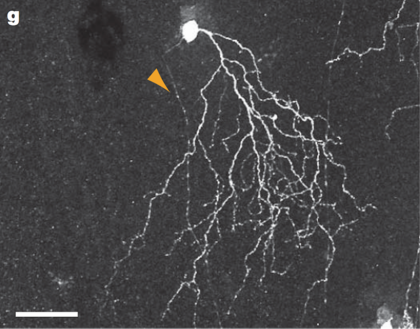Latest revision as of 16:29, 17 November 2015
Information about message (contribute ) This message has no documentation.
If you know where or how this message is used, you can help other translators by adding documentation to this message.
Message definition (Dendrite )
== Dendritic Arbor ==
== Dendritic Arbor ==
[[Image:jamb010_side.png|thumb|right|420px|A side view of a JAM-B cell showing the asymmetrical dendritic field.<ref name="kim2008" />]]
The dendrites of a neuron are thin and branch often, close to the cell body. Based on the specific pattern of the dendrites branching, or a neuron's dendritic arbor, neuroscientists are able to classify the neuron. [[JAM-B Cell| JAM-B cells]] a particularly notable example of how a cell's dendritic arbor can be used to identify a cell. In about 85% of JAM-B cells, there exists a marked asymmetry in the dendritic arbor.<ref name="kim2008">In-Jung Kim et al. [http://hebb.mit.edu/courses/connectomics/Kim%20molecular%20identification%20retinal%20cell%20type%20upward%20motion%2008.pdf Molecular identification of a retinal cell type that responds to upward motion] (2008). Nature <strong>452</strong>: 478-482</ref> Translation == Dendritic Arbor == Dendritic Arbor A side view of a JAM-B cell showing the asymmetrical dendritic field.
[1]
The dendrites of a neuron are thin and branch often, close to the cell body. Based on the specific pattern of the dendrites branching, or a neuron's dendritic arbor, neuroscientists are able to classify the neuron.
JAM-B cells a particularly notable example of how a cell's dendritic arbor can be used to identify a cell. In about 85% of JAM-B cells, there exists a marked asymmetry in the dendritic arbor.
[1]
↑ 1.0 1.1 In-Jung Kim et al. Molecular identification of a retinal cell type that responds to upward motion (2008). Nature 452 : 478-482
